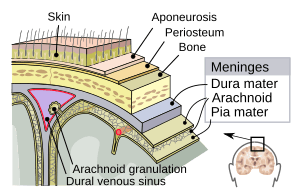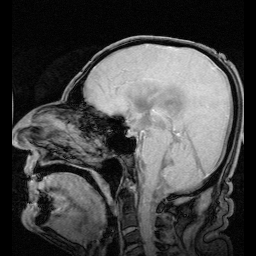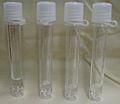Cerebrospinal fluid facts for kids

Cerebrospinal fluid (CSF) is a clear liquid that surrounds and protects your central nervous system. This includes your brain and spinal cord. The name "cerebrospinal" comes from "cerebro" (meaning brain) and "spinal" (meaning spinal cord).
CSF is made by special groups of blood vessels called choroid plexuses. These are found in each of the four spaces inside your brain, called ventricles.
The CSF flows around your brain in a space called the subarachnoid space. This space is between two of the protective layers around your brain, called the meninges. CSF also fills the brain's ventricles and flows down a tiny tube in the middle of your spinal cord, called the central canal.
Contents
What is CSF Made Of?
CSF is created from the liquid part of your blood, called blood plasma. This means CSF is very similar to plasma. It is mostly water, about 99% water!
CSF carries important things like:
- Protein (but much less than blood plasma)
- Glucose (sugar)
- Nutrients
- Neurotransmitters (chemical messengers for your brain)
- Electrolytes (salts like sodium, potassium, calcium, magnesium, and chloride)
Normally, there should be very few or no white blood cells in your CSF. There should never be any red blood cells.
What Does CSF Do?
CSF Helps Your Brain Float
Your brain is surrounded by CSF, which helps it float inside your skull. Think of it like a buoy floating in water. Because your brain floats in this fluid, it feels much lighter, like it only weighs 2% of its actual weight!
If your brain didn't have CSF to float in, it would rest directly on the bottom of your skull. Its weight would press down on the blood vessels there. This would stop blood from reaching the bottom of your brain. Without blood and the oxygen it carries, the brain cells (called neurons) in that area would die.
CSF is Your Brain's Cushion
CSF also protects your brain by acting like a cushion. Without CSF, every time you moved your head, your brain could bump against the inside of your skull. This could injure your brain.
When you hit your head, CSF works a bit like an airbag in a car. It can sometimes stop your brain from hitting the inside of your skull too hard. However, if you hit your head very hard, like in a car accident, the CSF might not be enough to protect your brain. This can lead to concussions, bleeding in the brain, or brain damage.

CSF Cleans Your Brain
Your brain cells do many chemical reactions to work properly. These reactions can leave behind "waste products" that the brain doesn't need. For example, when your brain cells use oxygen and sugar to make energy, they produce carbon dioxide. Too much carbon dioxide can be harmful to the brain.
To keep these waste products from building up, your choroid plexuses make new CSF about four times a day. The old CSF, carrying the waste products and toxins, drains into your bloodstream. This way, the CSF helps rinse out things that could harm your brain. Your bloodstream then carries these chemicals to organs like your kidneys and lungs, which can get rid of them. For instance, carbon dioxide goes to your lungs to be breathed out.
Testing CSF
Doctors can take small samples of CSF to check for problems. These samples can help them find out if someone has a brain infection, like meningitis or encephalitis. CSF samples can also show if there is bleeding in certain parts of the brain. Swelling in the brain, caused by some inflammatory diseases like multiple sclerosis, can also be seen in a CSF sample.
Doctors usually get a CSF sample by doing a lumbar puncture, also known as a spinal tap.
What the Results Mean
Normal CSF should be clear and colorless. It should have no red blood cells and very few white blood cells.
Signs of a brain infection might include:
- CSF that looks cloudy, yellow, or pink
- More protein in the CSF than normal
- More white blood cells in the CSF than normal
- Less glucose (sugar) in the CSF than normal
- Finding Bacteria, viruses, fungi, or other pathogens in the CSF
Higher than normal protein levels can mean there's inflammation in the brain. They can also point to other issues, like bleeding in the brain, a brain tumor, or epilepsy.
Finding Cancer cells in the CSF is a sign that a person has brain cancer, or that cancer from another part of the body has spread to the brain.
Problems with CSF
Too Much CSF
Sometimes, after head injuries or because of certain diseases, too much CSF can build up in the brain. This condition is called hydrocephalus. The extra fluid puts pressure on (squeezes) the brain. This is known as increased intracranial pressure. If the pressure gets too high, it can crush the brain's blood vessels, stopping blood from reaching the brain. If the brain doesn't get enough blood and oxygen, brain cells will die, and the person can become unconscious.
Without treatment, many people with hydrocephalus can face serious problems. They might have physical disabilities, intellectual disabilities, or other brain issues.
Not Enough CSF
Sometimes, CSF can leak out through a small hole or tear in the dura mater. The dura mater is the tough outer layer of the meninges, close to the skull and spinal bones. CSF leaks often happen after a lumbar puncture or certain surgeries on the head, neck, or brain. An injury to the head or spine can also cause a CSF leak. Sometimes, doctors can't find a clear reason for a leak.
Most people with CSF leaks get better on their own once the hole in the dura mater heals. However, some CSF leaks can lead to serious problems:
- Bacteria, viruses, or other pathogens can enter through the same hole the CSF is leaking from. This can cause brain infections like meningitis.
- Without enough CSF to float in, the brain can settle lower in the skull. The brain's weight can:
- Crush blood vessels at the bottom of the brain.
- Press on the brainstem, which can cause very low blood pressure.
- Push the brain down through the hole at the bottom of the skull, where the brainstem connects to the spinal cord. This can lead to paralysis or brain damage.
Related pages
Images for kids
See also
 In Spanish: Líquido cefalorraquídeo para niños
In Spanish: Líquido cefalorraquídeo para niños


